Award of Excellence
Lakeside Retreat
New England, USA
Richardson & Associates, Landscape Architects, Saco, ME USA
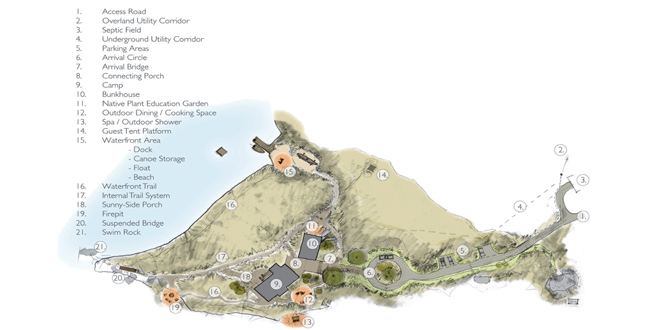
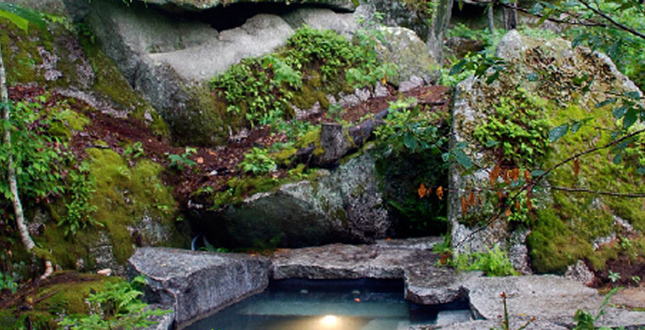 Close Me!
Close Me!A dramatic cliff condition inspired the siting and approach to the spa that related its size, form, and materials directly to the site: In concept the spa became a water-filled "negative boulder" sitting in a "boulder garden".
Download Hi-Res ImagePhoto: Todd A. Richardson
Photo 2 of 16
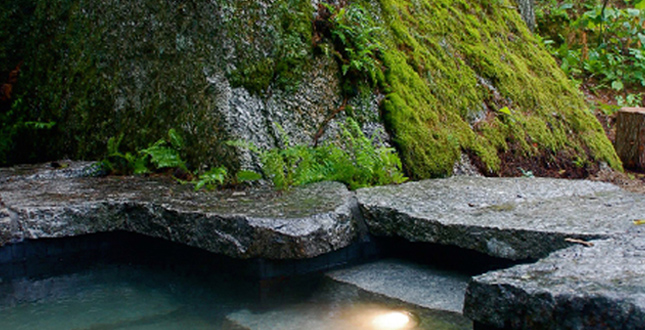 Close Me!
Close Me!A detail of the entry into the spa. Great care was taken throughout construction, including temporary irrigation to preserve the existing mosses and lichens on this stone.
Download Hi-Res ImagePhoto: Todd A. Richardson
Photo 3 of 16
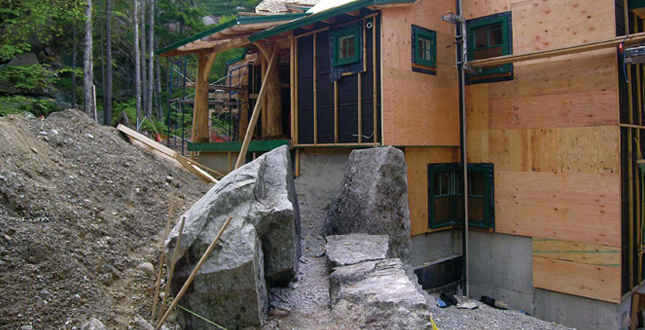 Close Me!
Close Me!Significant pieces of stone were placed at camp’s corner, allowing for a full floor grade change to occur around this end of the building, and to give the sense that the camp was built on the rock itself.
Download Hi-Res ImagePhoto: Todd A. Richardson
Photo 4 of 16
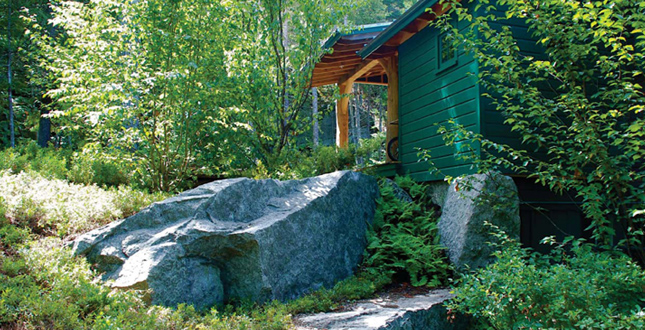 Close Me!
Close Me!Six months after completion, the finished and planted condition mimics the look and feel of adjacent natural ledge outcroppings around which the camp was sited and constructed.
Download Hi-Res ImagePhoto: Todd A. Richardson
Photo 5 of 16
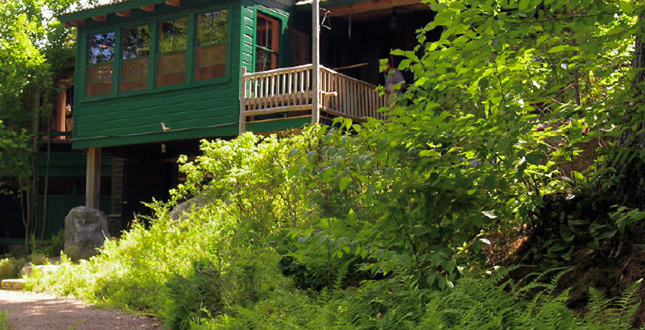 Close Me!
Close Me!By "pushing" the building into the landscape its scale was mitigated while allowing three floors of living space to view to the lake.
Download Hi-Res ImagePhoto: Todd A. Richardson
Photo 6 of 16
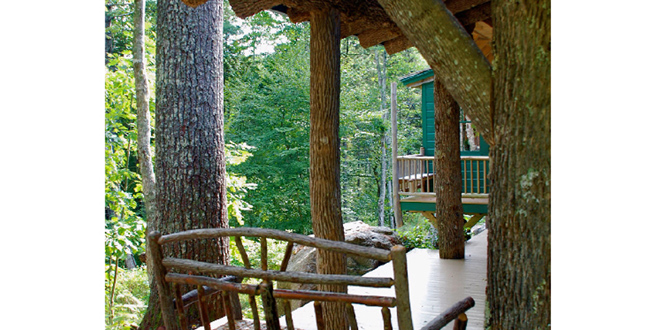 Close Me!
Close Me!"Stitching" the proposed with the existing: a boulder placed just off the porch; the preservation of a pine just off the porch and "bark on" log support columns to reference the trees of the adjacent woodlands.
Download Hi-Res ImagePhoto: Todd A. Richardson
Photo 7 of 16
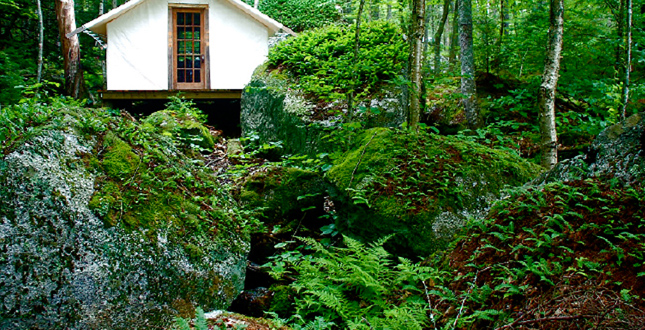 Close Me!
Close Me!Guest accommodations are provided in adjunct structures such as this tent platform which was located in the woods to capture the spirit of the site.
Download Hi-Res ImagePhoto: Todd A. Richardson
Photo 8 of 16
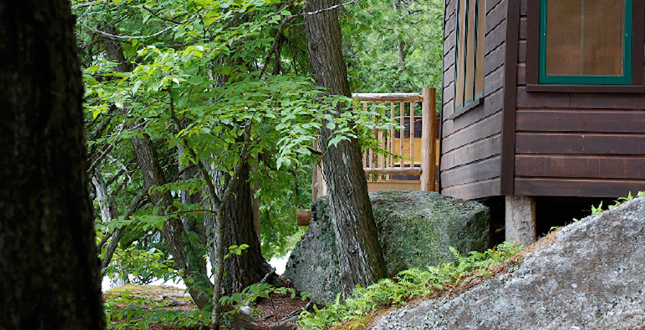 Close Me!
Close Me!Guest accommodations are also provided at a more remote camp, accessible only by boat. Construction materials were brought to the site over the ice during the winter and plant materials by boat during the limited planting season.
Download Hi-Res ImagePhoto: Todd A. Richardson
Photo 9 of 16
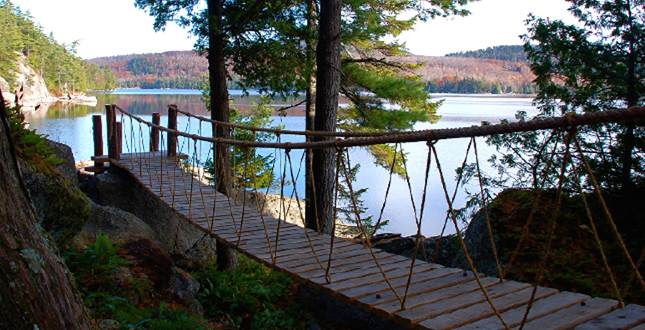 Close Me!
Close Me!The suspended footbridge launches outward from the forest, vaulting over an existing ledge and providing access to the "swim rock."
Download Hi-Res ImagePhoto: Todd A. Richardson
Photo 10 of 16
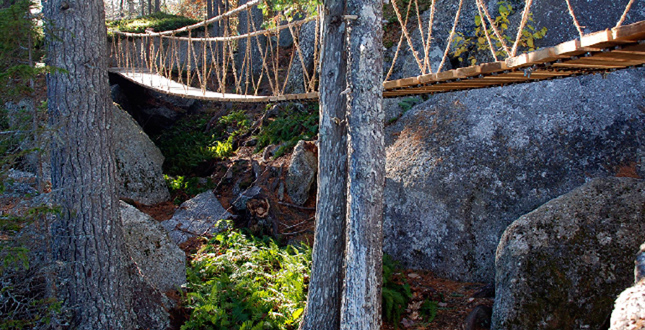 Close Me!
Close Me!The suspended footbridge from below, anchoring back into the forest and boulder condition.
Download Hi-Res ImagePhoto: Todd A. Richardson
Photo 11 of 16
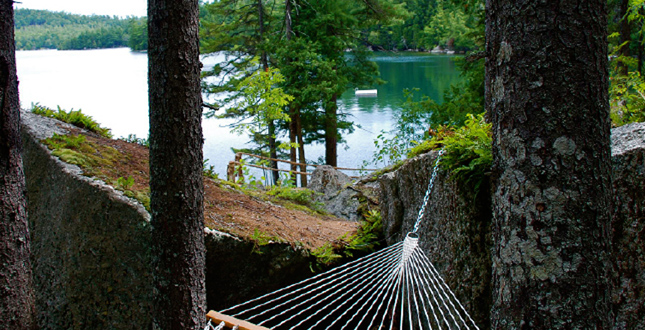 Close Me!
Close Me!Hammocks were sited in private areas among the boulders to provide a place of solace with a view.
Download Hi-Res ImagePhoto: Todd A. Richardson
Photo 12 of 16
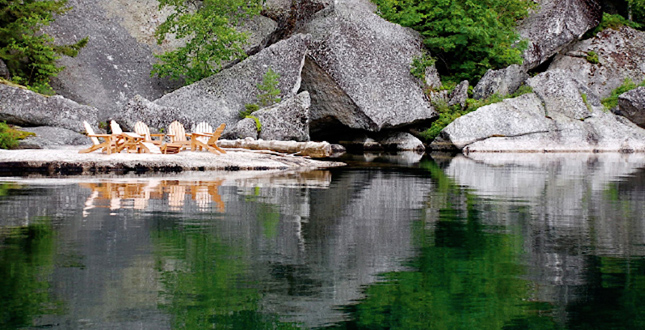 Close Me!
Close Me!A new stone bridge provided access from the shore to this "swim rock" where family and guests can enjoy the lake from this unique vantage point.
Download Hi-Res ImagePhoto: Todd A. Richardson
Photo 13 of 16
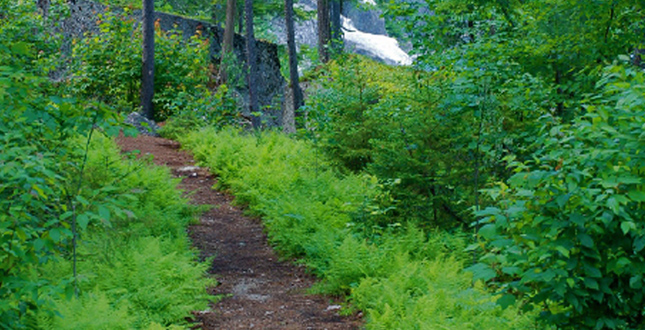 Close Me!
Close Me!The path to the "swim rock" — previously a rutted ATV trail.
Download Hi-Res ImagePhoto: Todd A. Richardson
Photo 14 of 16
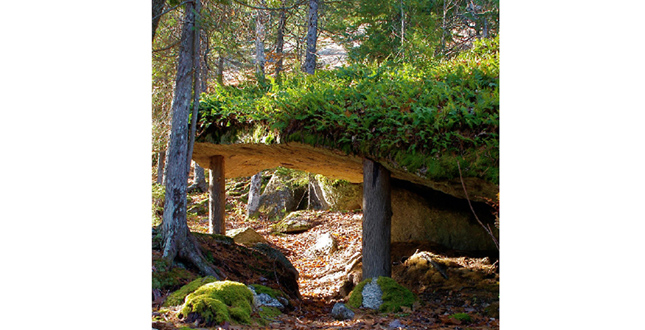 Close Me!
Close Me!The trail network connects many special features of the property. In this case it passes under a large fern-laden stone en route from the waterfront up to the main camp.
Download Hi-Res ImagePhoto: Todd A. Richardson
Photo 15 of 16
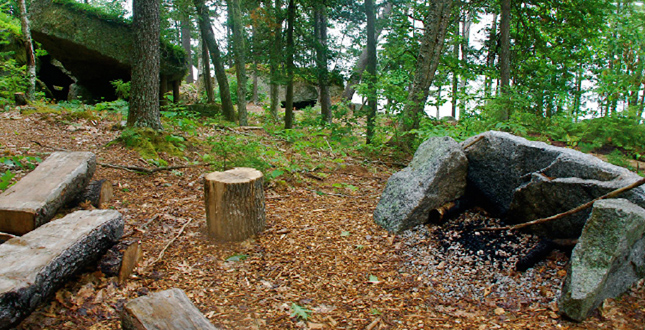 Close Me!
Close Me!Foot trails connect many places on the property including this campfire area which has filtered views to the lake beyond.
Download Hi-Res ImagePhoto: Todd A. Richardson
Photo 16 of 16
Project Statement
Capturing the rugged spirit and the landscape-rooted qualities of rustic camps of bygone eras, the Firm developed a family retreat at a remote lakeside location which protects, maintains, and builds upon the site's unique landscape qualities. The design effort draws upon the site, establishing a distinct closeness with nature in creating a place of respite, solitude, and peace.
Project Narrative
—2010 Professional Awards Jury
Given this project's primary goal of drawing on the inherent qualities of site to establish a rustic New England Lakeside Retreat, the site was carefully chosen for its confluence of several significant natural features and themes. The 369-acre site is heavily wooded with a mix of hardwood and softwood species and a light density of native understory trees, shrubs, and ground covers—creating a dappled green woodland with a navigable forest floor, through which glimpses of the water may be seen. The lake's remote and undeveloped qualities are highlighted by the dramatic stone boulders and ledge cliffs which tumble to its shores. The camp is sited on a small cove. It sits between a stream to the south that trickles across the forest floor and fans out into rich wetland flats, and steep granite cliffs to the north which fall directly to the water. Nestled between these features, the camp is tucked into a small slope where the ledge ridge pulls away from the water's edge, leaving enormous broken boulders draped in moss and ferns.
The design intent for all aspects of the project—from camp siting to infrastructural engineering and landscape design—was simple: to "surgically insert" the new camp and its associated needs into the existing landscape while protecting, maintaining, and building upon its special qualities and features. To achieve this end of both conserving and amplifying the key existing site features it was important to fully understand the landscape's characteristics and spirit to ensure that the proposed improvements would be firmly rooted in the present condition. The firm's intent was to provide experiences through exemplary design which would establish reciprocity with—and create a closeness to—the site. In doing so, the Camp would truly become a place of reflection, recreation, and celebration—for the family and their guests.
Within the framework of this special site and specific design intent, the landscape architect was charged with a wide spectrum of tasks: to establish access to the project site (almost a mile from the nearest existing gravel road), to site buildings and structures, and to provide for the necessary utilities and infrastructure to support the camp. Within the lakeside precinct of the camp proper, the landscape architect planned, designed, and implemented spaces and facilities for numerous outdoor land- and water-based uses.
To deliver on these tasks, the firm provided a comprehensive set of site and landscape architectural design, permitting, documentation, and construction administration services as an integrated part of a collaborative team. In conjunction with surveyors, attorneys, and environmental specialists, the firm played an important role in the earliest phases of the project—assessing and identifying the opportunities and constraints associated with the property before it was formally purchased. The firm then coordinated permitting and approval efforts at both the local and state levels. Once purchased and permitted, the firm planned and coordinated site access and utilities infrastructure, including layout for a woodland access road and power, septic, and well services. These efforts were complicated by the remoteness of the site and site constraints such as an abundance of ledge, steep slopes, and wet areas. To support the overarching project goal of creating a rustic environment, a decision was made to hide modern infrastructure wherever possible, and a combination of above (where necessary) and below ground (when practical) utilities was implemented to meet this goal within the framework of the challenging site.
The firm's planning and design efforts included working closely with the project architects on location during development of the main camp. Additionally, the firm provided planning, permitting, design, documentation, and administration services for the siting of a guest camp, landscape restoration associated with a secondary cabin accessible only by boat, establishment of a trail network, a spa and outdoor shower, a woodland fire pit, an educational garden, a suspended footbridge, waterfront areas (including docks, floats, and a swimming rock), as well as several outdoor seating/gathering areas.
The significance of this project lies in the noteworthy efforts to conserve and integrate emblematic features of the existing landscape into the project's planning, design, and implementation. Large mature trees, massive mossy boulders, striking ledge outcroppings, glades of ferns, drifts of shrubs, and key views were all carefully noted, inventoried, and preserved early in the design process. The level of detail in inventorying these elements before construction began, the education of the client/design/construction team as to the value of conserving them, and the methods employed in protecting these resources during construction were all critical to the project's successful outcome. Several examples of this include: protecting tree trunks and root zones throughout the site to limit construction effects and ensure that the future camp would "float" among large, healthy, existing trees; tying back small saplings and overhanging tree limbs along the newly created access road during construction in order to avoid damage to these elements and preserve the finished quality and enclosed scale of the woodland road when complete while still allowing for temporary access at a much larger scale; and placing burlap over key vegetated boulders and providing irrigation to them during construction to preserve the lichens and mosses growing there from physical harm or harsh micro-climatic conditions caused by a temporarily "open" job site.
In places where construction or past use had negatively impacted the landscape, a "restoration effort" was mounted, integrating new with old. Revegetation efforts used a palette of plant species from the site—sometimes using actual transplanted groundcover mats and sapling stands—and planted these species in complex naturall—occurring combinations and compositions. Blueberry and huckleberry sods, rhodora, sheep laurel, a multitude of fern species, bunchberry, yellow birch, red oak, maples, spruce, and viburnum were planted in masses and drifts as they would appear in the natural surroundings. To support this restoration effort, a team of native plant experts from a regional botanical garden assisted in transplanting an array of native plant species from the larger site into a native plant identification garden close to the camp. These specimens were then labeled so that the client's family, their children, and guests could become familiar with the plants commonly found throughout the property.
Another tool for stitching the proposed into the existing was the introduction of landscape-scale stones whose size, shape, grain, color, and patina were carefully matched to the site by sourcing new stone from old quarry tailings in a nearby granite pit. "New stone" was introduced to integrate the camp into the surrounding landscape by placing significantly sized boulders and stone pieces in key locations—literally "rooting" the architecture in the landscape by arranging the stone in ways that replicate the geological history already evident on the site. This effort is illustrated in the placement of massive fingers of stone in a radiating pattern extending out from the southwest corner of the camp. The resulting impression is that the camp was built into this ledge, rather than the other way around. In another example, the siting and design of the spa grew out of the idea of water filling a void where a boulder may have lain. By painstakingly preserving a pocket of large boulders off the back of the camp during construction, using native stone in and around this area, and strategically setting additional weathered boulders tumbling into the spa void, the "boulder hole" concept is achieved.
Finally, once mats of native vegetation were introduced to stitch together the seam between new and old across the site, the rustic Lakeside Retreat was effectively anchored to the landscape and the story of site preservation and amplification was completed.
Project Resources
Landscape Architect
Richardson & Associates Landscape Architects
Todd A. Richardson, ASLA
Architects
Whitten Architects
Rob Whitten, Principal
Will Winkleman, Project Architect
Building Contractor
Cold Mountain Builders, Inc.
Landscape Contractor
Atlantic Landscape Construction
Mason
Freshwater Stone and Brick
Site Work
Lynch Construction
Soil Scientist
Moyse Environmental Services, Inc.
Structural Engineer
Albert Putnam, PE






